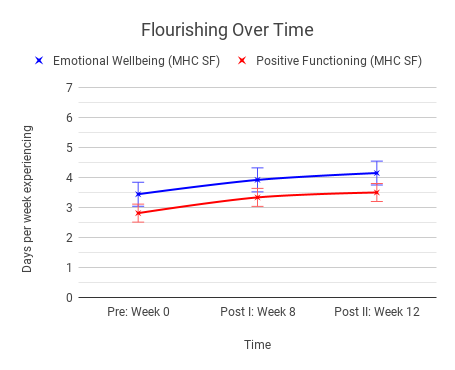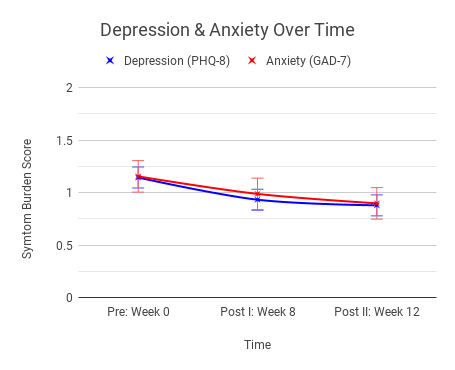The Science Behind Rethink Wellbeing
We use the latest evidence on psychotherapeutic and behaviour change methods to design, evaluate and improve all of our services. Research suggests our CBT and IFS Labs are likely to be as effective and engaging as traditional one-on-one therapy while costing participants 3 times less.
Updated October 2024
23%
decrease in symptoms of depression after 12 weeks
25%
increase in positive functioning after 12 weeks
25%
increase in productivity after 12 weeks
22%
decrease in symptoms of anxiety after 12 weeks
20%
increase in emotional wellbeing after 12 weeks
Our research suggests Rethink Wellbeing can make a big difference.
We run longitudinal studies alongside every program to measure impact, estimate cost-effectiveness, and benchmark against other mental health services.
We employ gold-standard methods used in clinical trials where possible and use standardized self-assessments aligned to common psychological scales.
Data from 71 participants in our 2023 and 2024 CBT Lab Peer Support program.
Read about the psychometric scales we use in our research here.
We leverage cutting-edge self-help content, enhanced by peer support, to provide cost-effective mental health and wellbeing programs.
Our programs are designed to offer maximum benefits while minimizing the resources needed. This helps us keep our services affordable and reach more people.
We integrate well-established frameworks like peer counselling and support groups, with proven self-help resources such as audiobooks, workbooks, and digital courses. The evidence-based psychotherapeutic and behaviour change methods taught in our programs offer accessible solutions that can be implemented wherever and whenever needed. The techniques we focus on are effective and fast-acting.
Multiple meta-analyses show that digital self-help resources—when paired with guidance from trained peers—can be as effective and engaging as traditional one-on-one therapy (e.g. Baumeister et al., 2014). This innovative format also costs participants 3 times less in our case.
Our programs target better mental health and productivity so that our ambitiously altruistic participants feel better and achieve more. Our latest research suggests that on average participants gain 6 weekly working hours. This represents a 15% increase in productivity worth $9,200 of a full-time worker’s median income in the USA. To put this into context, GiveWell’s top charities can save a life for ~$5,000.
You can find a more detailed analysis and a link to our cost-effectiveness analysis in our EA Forum post.
Our Latest Results
CBT Lab Peer Support Program 2023-24
N: 88 participants completed a Wellbeing Evaluation before the program and at least once more on Week 8 or Week 12

Overall wellbeing increased by 15% after 12 weeks which is roughly 1 point on the 0-10 WELLBY scale. This is greater than the increases seen from becoming partnered (+0.59) or finding employment (+0.70), when compared with findings from other cross-sectional studies.

CBT Lab Peer Support participants experienced feelings associated with flourishing 20-25% more often.

CBT Lab Peer Support participants' symptoms of depression and anxiety reduced by 22%.

CBT Lab Peer Support participants' symptoms associated with interpersonal sensitivity and executive dysfunctions reduced by 11-15%.


